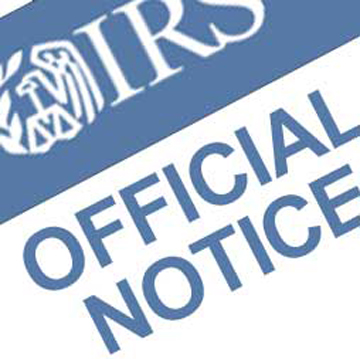AuthorSkip Lovette, CPA Archives
March 2021
Categories |
Back to Blog
 Each year the IRS mails millions of notices and letters to taxpayers. If you receive a notice from the IRS, here is what you should do: Don’t Ignore It. You can respond to most IRS notices quickly and easily. It is important that you reply right away. Focus on the Issue. IRS notices usually deal with a specific issue about your tax return or tax account.Understanding the reason for your notice is important before you can comply. Follow Instructions. Read the notice carefully. It will tell you if you need to take any action to resolve the matter. You should follow the instructions. Correction Notice. If it says that the IRS corrected your tax return, you should review the information provided and compare it to your tax return. If you agree, you don’t need to reply unless a payment is due. If you don’t agree, it’s important that you respond to the IRS. Write a letter that explains why you don’t agree. Make sure to include information and any documents you want the IRS to consider. Include the bottom tear-off portion of the notice with your letter. Mail your reply to the IRS at the address shown in the lower left part of the notice. Allow at least 30 days for a response from the IRS. Premium Tax Credit. The IRS may send you a letter asking you to clarify or verify your premium tax credit information. The letter may ask for a copy of your Form 1095-A, Health Insurance Marketplace Statement. You should follow the instructions on the letter that you receive. This will help the IRS verify information and issue the appropriate refund. No Need to Visit IRS. You can handle most notices without calling or visiting the IRS. If you do have questions, call the phone number in the upper right corner of the notice. You should have a copy of your tax return and the notice with you when you call. Keep the Notice. Keep a copy of the notice you get from the IRS with your tax records. Watch Out for Scams. Don’t fall for phone and phishing email scams that use the IRS as a lure. The IRS first contacts people about unpaid taxes by mail – not by phone. The IRS does not initiate contact with taxpayers by email, text or social media. For more information, call us at 336.346.1960 or e-mail [email protected]
2 Comments
Read More
Back to Blog
 2014 was a big year for small business. More businesses were sold than ever, and small businesses added over a million workers last year. Even more changes are on the horizon this year; here are five to watch for: Tax Reform In late December, Congress lengthened about 50 tax breaks or “extenders” through the end of the year. Some, like accelerated expensing of certain asset purchases, could be particularly helpful for small businesses. The IRS also has 13,000 less employees than it did at the end of the 2010 fiscal year, and they must absorb a $1.2 billion budget cut from last year. This means a 50% reduction in the level of customer service available, and lower audit pressure. There’s also a movement building in the Senate to allow the government to regulate tax preparers. A potential bill would subject them to mandatory tests and continuing education requirements – the cost of which might be passed on to clients. Health Care Starting this year, companies with over 50 employees are required to offer insurance. The newly appointed chairman of the House Small Business Committee, Steve Chabot, plans to hold hearings this year to advocate for small businesses mostly focusing on the Affordable Care Act. The House also recently passed a bill to raise the requirement for employee coverage from 30 hours per week to 40 hours per week, essentially reducing the number of workers who need to be covered. Taxation of Online Sales To level the playing field between brick-and-mortar stores and online merchants, the Senate passed the Marketplace Fairness Act in May 2013. The act would have allowed states to collect sales tax on purchases made by its states residents, regardless of where the seller is located. The bill stalled in the 2014 session of Congress, but with such a high amount of tax revenue at stake, businesses might be hearing more from this bill in 2015. Data Security and Online Privacy Datamation predicts many changes in the way data is stored and protected this year. Cloud-data storage is becoming more popular, since it allows for better collaboration and automatic backups. The recent hack of Sony Pictures brought the threat of data insecurity to the public’s attention. President Obama has called for stronger regulation in this area, including a law that would require companies to notify customers within thirty days if their personal information had been exposed. Mobile Payments With the growing popularity of mobile payment and the increased frequency of large-scale data breaches, the movement toward greater payment security is inevitable. Small businesses should definitely consider making the accommodations to accept mobile payments to attract and retain the tech-savvy customer. All of these changes can be hard to keep track of, and some have even said that the government should create a “Roadmap” website to aggregate local, state, and federal regulation changes. That way, businesses would be able to search by location and industry to see what regulations apply to them. Until then, though, keeping track of these five can help your business stay ahead in 2015. For more information, call us at 336.346.1960 or e-mail [email protected]
Back to Blog
Choose the Right Filing Status2/11/2015 It’s important that you use the correct filing status when you file your tax return. Your status can affect the amount of tax you owe for the year. It may even affect whether you must file a tax return. Keep in mind that your marital status on Dec. 31 is your status for the whole tax year. Sometimes more than one filing status may apply to you. If that happens, choose the one that allows you to pay the lowest tax.
Here’s a list of the five filing statuses: 1. Single. This status normally applies if you aren’t married. It applies if you are divorced or legally separated under state law. 2. Married Filing Jointly. If you’re married, you and your spouse can file a joint tax return together. If your spouse died in 2014, you often can file a joint return for that year. 3. Married Filing Separately. A married couple can choose to file two separate tax returns. This may benefit you if it results in less tax than if you file a joint tax return. It’s a good idea for you to prepare your taxes both ways before you choose. You can also use it if you want to be responsible only for your own tax. 4. Head of Household. In most cases, this status applies if you are not married, but there are some special rules. You also must have paid more than half the cost of keeping up a home for yourself and a qualifying person. Don’t choose this status by mistake. Be sure to check all the rules before you file. 5. Qualifying Widow(er) with Dependent Child. This status may apply to you if your spouse died during 2012 or 2013 and you have a dependent child. Certain other conditions also apply. Note for same-sex married couples. In most cases, you and your spouse must use a married filing status on your federal tax return if you were legally married in a state or foreign country that recognizes same-sex marriage. That’s true even if you now live in a state that doesn’t recognize same-sex marriage. For more information, call us at 336.346.1960 or e-mail [email protected]
Back to Blog
Why Use a CPA to Prepare Your Taxes7/6/2014 Licensing - Practicing CPAs are licensed through their particular state. In order for the CPA to maintain this license, he/she must generally do 2 things: complete continuing education (e.g. take a course on the latest tax deductions) and run his/her business according to specific standards. These standards provide assurance to you that you’re getting a quality service. If you ever have a question about your CPAs legitimacy, contact your state’s board of public accountancy and request information about your CPA.
Consistency and Stability- A CPA is going to be there for you year after year. Practicing CPAs are in it for the long run. Doors are Always Open – A CPA performs many types of financial services, not just taxes. Therefore, their doors are always open for tax questions, tax planning, and for any audit help you may need. Other tax preparation services are going to close their doors from May to December. Who’s going to help you when you get that audit letter? A CPA can. Record Retention- A CPA is going to maintain your tax information much like a doctor holds on the patient’s medical records. A CPA will act as your own personal filing cabinet through the years. You’ll even get your own copy of the return and supporting documents in a nice little folder for you to file away yourself if you want. Digital is also becoming more prevalent. Tax Planning – The best part about having a CPA is the tax planning advice he can provide throughout the year. There are certain year-end tax moves you can make each year that will save you hundreds in tax dollars. Software and tax preparation companies aren’t around to help you with those things. Professionalism - Like I mentioned above, a CPA is licensed with the state. They’ve gone through a ton of accounting classes, a tough exam, and must maintain continuing education credits each year. Only a person who wants to be a professional is willing to go through what it takes to be a CPA. Of course, CPAs are still just people. But I’ll take the CPA designation over any other for tax filing purposes. Your Time – The last good reason I’ll give you is your time. I’m not going to lie and say that you won’t have to spend a little time preparing your tax files to bring to a CPA. But they will save you the time it takes to enter in all the information, and file the return. And each year it gets quicker as you’ll learn what to bring to your CPA. For more information, call us at 336.346.1960 or e-mail [email protected]
Back to Blog
Retirement savings tax tips5/30/2014 You might be able to muddle through retirement without knowing each and every line of Uncle Sam's tax code. But you'll likely give the federal government more than its fair share of your nest egg if you don't know some simple tips.
If a person engages in what's called a prohibited transaction with his or her IRA, it may no longer qualify for tax benefits. And no one, perhaps save the U.S. Treasury Department, wants that to happen. People to understand what is a prohibited transaction. Besides prohibited transactions, here are some facts: • When are funds in an IRA taxed? Funds accumulated in a traditional IRA generally are not taxable as ordinary income until they actually are distributed. Funds accumulated in a Roth IRA may or may not be taxable on distribution, depending on whether they've meet certain requirements including the five-year waiting rule, he says. • How are earnings on a traditional IRA taxed? An IRA offers tax-free build up on contributions. The earnings on a traditional IRA are tax-deferred to the owner; that is, they are not taxed until the owner begins receiving distributions. Of note: IRAs are subject to taxes for what's called unrelated business income. • What is compensation for purposes of IRA eligibility rules and deduction limits? Compensation, for purposes of the eligibility rules and deduction limits that apply to IRAs, means wages, salary, professional fees, or other amounts derived from, or received for, personal services actually rendered. "Compensation" also includes alimony paid under a divorce or separation agreement that is includable in the income of the recipient under IRC Section 71. For those who are self-employed, "compensation" includes earned income from personal services, but in computing the maximum IRA or SEP contribution, such income must be reduced by: Any qualified retirement plan contributions made by such individual on his or her own behalf 2) The 50% of self-employment taxes deductible by the individual. • Are fees or commissions paid in connection with an IRA deductible? The IRS has ruled that the payment of administrative or trustee fees incurred in connection with an IRA may be claimed as a miscellaneous itemized deduction if such fees are separately billed and paid. If separately billed and paid, the payment of such fees does not constitute a contribution to the IRA and thus will not be an excess contribution or reduce the amount that may be contributed to the account or, in the case of a traditional IRA, deducted. Deduction of administrative fees is subject to the 2% floor on miscellaneous itemized deductions. • Is interest paid on amounts borrowed to fund an IRA deductible? The IRS has ruled that interest paid on amounts borrowed to fund an IRA is not designated as tax-exempt income. The deduction of such interest is not subject to the general prohibition against deducting interest incurred or carried to purchase tax-exempts. Because such interest is 'on amounts borrowed to buy or carry property held for investment,' it would seem that it should be classified as 'investment interest expense' and the deduction limited. • What is the penalty for making excessive contributions to an IRA? If contributions are made in excess of the maximum contribution limit for traditional IRAs or Roth IRAs, the contributing individual is liable for a nondeductible excise tax of 6% of the amount of the excess. But it's not to exceed 6% of the value of the account or annuity, determined as of the close of the tax year. Note that a contribution by a person ineligible to make the contribution is considered an excess contribution even if it is made through inadvertence. • When can IRA contributions be withdrawn or reduced? Any IRA contribution may be withdrawn, together with the net income attributable to such contribution, on or before the due date for filing the federal income tax return of the contributing individual and the amount will be treated as if never contributed, regardless of the size of the contribution. Such a distribution is not included in gross income and is not subject to the 10% early distribution excise tax. A distribution of an excess contribution also is not subject to the 6% excess contribution excise tax. The accompanying distribution of the net income, however, is includable in income and is subject to penalty as an early distribution. Net income attributable to a contribution is determined by allocating to the contribution a pro-rata portion of the earnings or losses accrued by the IRA during the period the IRA held the contribution, Net income may be a negative amount. • How are amounts distributed from a traditional IRA taxed? Distributions from a traditional IRA generally are taxed under Internal Revenue Code Section 72, according to Byrnes. And under these rules, he says a portion of the distribution may be excluded from income. "The amount excludable from the taxpayer's income for a year is that portion of the distribution that bears the same ratio to the amount received as the taxpayer's investment in the contract, that is, nondeductible contributions, bears to the expected return under the contract," he says. "In no case will the total amount excluded exceed the unrecovered investment in the contract." • How are amounts distributed from a Roth IRA taxed? Where a Roth IRA contains both contributions and conversion amounts, there are ordering rules that apply in determining which amounts are withdrawn. In applying the ordering rules, however, traditional IRAs are not aggregated with Roth IRAs. But all Roth IRAs are aggregated with each other. Regular Roth IRA contributions are deemed to be withdrawn first, then converted amounts second in order if there has been more than one conversion. Withdrawals of converted amounts are treated first as coming from converted amounts that were includable in income. The ordering rules continue to treat earnings as being withdrawn after contributions. For more information, visit www.lovettecpa.com
Back to Blog
WASHINGTON, D.C. (MARCH 26, 2014)
BY GREG STOHR BLOOMBERG (Bloomberg) The U.S. Supreme Court decided in favor of the Obama administration in a dispute over taxes on severance compensation, overturning a lower court decision that could have forced the IRS to refund more than $1 billion. The court said payments to laid-off workers are subject to Social Security and Medicare taxes under the Federal Insurance Contributions Act, or FICA. It was a victory for the Internal Revenue Service, which has been fighting more than 2,400 refund claims from companies and their ex-employees. The justices’ unanimous ruling yesterday came in the case of Quality Stores Inc., once the country’s largest agricultural specialty retailer. The defunct company fired 3,100 workers when it closed its stores in 2001 and 2002, paid the taxes on their severance and then asked a bankruptcy judge to order the IRS to refund $1 million. Writing for the court, Justice Anthony Kennedy said the payments were subject to tax. He rejected the company’s contention that what it called supplemental unemployment compensation was exempt from the FICA. “The severance payments here were made to employees terminated against their will, were varied based on job seniority and time served and were not linked to the receipt of state unemployment benefits,” he wrote. “Under FICA’s broad definition, these severance payments constitute taxable wages.” Unresolved Lawsuits Lower courts were divided on the issue. The high court ruling came in the government’s appeal of a September 2012 decision by a Cincinnati-based U.S. appeals court that said Quality Stores was entitled to a refund. The money would have gone to 1,850 ex-employees who paid their share of the taxes and authorized Muskegon, Michigan-based Quality Stores to try to recoup the payments on their behalf. “The decision is a huge blow for employers and employees alike,” said Bob Hertzberg, the lawyer who represented Quality Stores at the Supreme Court. “In addition to the impact on Quality Stores and its former employees, this ruling has far-reaching implications for the thousands of other organizations and workers fighting for refunds.” Kathryn Keneally, head of the Justice Department’s tax division, said the government is “pleased that the Supreme Court recognized that there should be no difference in how severance pay is taxed for social security and income tax purposes.” Program Financing FICA uses payroll taxes to finance Social Security and part of the Medicare health-care program for the elderly and disabled. Employers and employees each pay 6.2 percent in Social Security taxes on wages up to a cap, which is $113,700 this year, and they each pay 1.45 percent of all wages toward Medicare. High-income taxpayers are subject to additional payroll levies. According to a brief filed by the Obama administration, the claims for refunds have been made in 11 unresolved lawsuits and 2,400 administrative cases “with a total amount at stake of more than $1 billion.” “That figure is expected to grow,” the brief said. The case is United States v. Quality Stores, 12-1408. |
 RSS Feed
RSS Feed




